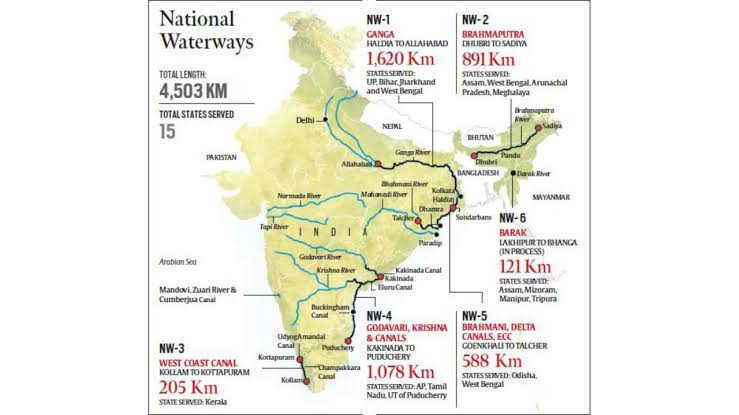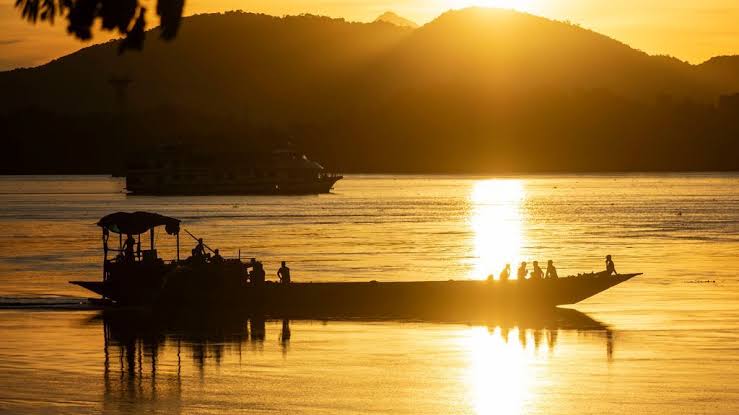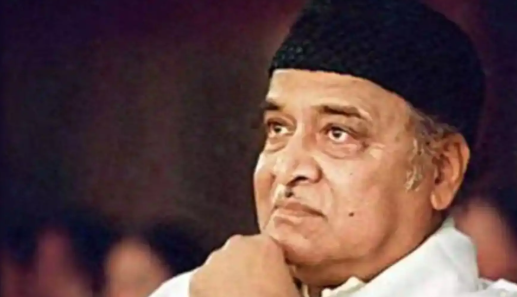India’s national waterways are vital for connecting rivers, canals, and backwaters to enhance trade, tourism, and eco-friendly transport. With 111 national waterways spanning over 20,000 km, India is leveraging this network to reduce road and rail congestion, lower logistics costs, and promote sustainable growth. Assam, with its extensive river systems, plays a key role in this network, hosting 15 national waterways. Below is an updated guide on India’s national waterways, with a focus on those in Assam, recent developments, and their significance.
What Are National Waterways?
National waterways are rivers, canals, and backwaters designated by the government for shipping and navigation. Managed by the Inland Waterways Authority of India (IWAI), these waterways facilitate efficient movement of goods and people. They are cost-effective, costing about 50 paise per kilometer compared to ₹1 for rail and ₹1.5 for roads, and are environmentally friendly, reducing carbon emissions and traffic congestion.
National Waterways in Assam
Assam has 15 national waterways, making it a critical hub for inland water transport in Northeast India. These waterways, covering nearly 10% of India’s total navigable length, support trade, connectivity, and tourism. Below is the complete list of national waterways in Assam, as per the National Waterways Act, 2016:
- National Waterway-2 (NW-2): Brahmaputra River (Dhubri to Sadiya, 891 km) – A key route connecting Assam to mainland India via the Indo-Bangladesh Protocol route.
- National Waterway-6 (NW-6): Aie River (139 km).
- National Waterway-8 (NW-8): Beki River (76 km).
- National Waterway-16 (NW-16): Barak River (Lakhipur to Bhanga, 121 km) – Connects to Bangladesh for trade.
- National Waterway-18 (NW-18): Buri Dihing River (114 km).
- National Waterway-31 (NW-31): Dhansiri River (110 km).
- National Waterway-33 (NW-33): Dibru River (66 km).
- National Waterway-38 (NW-38): Gangadhar River (62 km).
- National Waterway-40 (NW-40): Jinjiram River (44 km).
- National Waterway-52 (NW-52): Kopili River (46 km).
- National Waterway-57 (NW-57): Kumari River (65 km) – Recently operationalized for cargo movement.
- National Waterway-62 (NW-62): Lohit River (103 km).
- National Waterway-81 (NW-81): Puthimari River (72 km).
- National Waterway-94 (NW-94): Subansiri River (111 km).
- National Waterway-101 (NW-101): Tizu and Zungki Rivers (42 km).

National Waterways in India
Beyond Assam, some prominent national waterways include:
- National Waterway-1 (NW-1): Ganga-Bhagirathi-Hooghly (Haldia to Varanasi, 1,620 km), a major route for northern India.
- National Waterway-3 (NW-3): West Coast Canal (Kottapuram to Kollam, 205 km) in Kerala, boosting tourism and trade.
- National Waterway-4 (NW-4): Krishna-Godavari rivers and canals (1,095 km) in Andhra Pradesh and Tamil Nadu.
- National Waterway-5 (NW-5): Brahmani and Mahanadi Delta (623 km) in Odisha and West Bengal.
Recent Developments in National Waterways
India is actively enhancing its waterway infrastructure, with significant progress in Assam. Here are the latest updates:
- Operationalization of National Waterway-57 (NW-57): In August 2025, the Kopili River (NW-57) in Assam was operationalized with a trial cargo run of 300 MT of cement from Chandrapur to Hatsingimari. This marks a revival of Assam’s river-based trade and sustainable logistics after over a decade.
- Cargo Surge: Cargo movement across India’s waterways grew by 700% from 18 MT in 2013-14 to 145.5 MT in 2024-25, with a target of 156 MT by 2026. NW-1 saw a 152.75% cargo increase in 2023-24.
- Infrastructure Investments: Over ₹6,833.46 crore has been invested in the last five years for terminals and jetties. In 2025, projects worth ₹1,400 crore were launched, including a ₹208 crore ship repair facility at Pandu and a ₹180 crore road project for NW-2 in Assam.
- Northeast Focus: A ₹5,000 crore roadmap targets waterway development in the Northeast, including terminals on NW-16 (Barak) and NW-31 (Dhansiri). Projects worth ₹308 crore were unveiled in Assam and Tripura in 2024, including a passenger-cargo terminal at Bogibeel and upgraded terminals at Karimganj and Badarpur.
- Eco-Friendly Initiatives: The Harit Nauka Guidelines promote electric catamarans and hydrogen fuel-cell vessels. Six tourist jetties on NW-2 and two electric hybrid catamarans in Guwahati were announced for 2025.
- Digital Advancements: In April 2025, IWAI launched a digital portal for jetty and terminal construction. Tools like the Least Available Depth Information System (LADIS) and River Information Systems (RIS) improve navigation safety.
- Tourism Growth: River cruises are expanding, with 25 luxury cruise vessels operational and 51 more cruise circuits planned by 2027. World-class terminals are under development in Kolkata, Varanasi, and Guwahati.
Benefits of National Waterways
- Cost-Effective: Water transport is the cheapest mode for heavy goods like coal, cement, and fertilizers.
- Eco-Friendly: Reduces carbon emissions and eases road congestion.
- Regional Connectivity: Links remote areas, especially in Assam and the Northeast, to major markets via routes like the Indo-Bangladesh Protocol.
- Tourism Boost: River cruises highlight India’s cultural heritage, attracting tourists.
- Job Creation: New terminals and vessels generate employment in shipping and logistics.
Challenges
- Seasonal Rivers: Rivers like the Brahmaputra and Barak face low water levels in summer, hindering navigation.
- Environmental Impact: Dredging can affect ecosystems, such as the Gangetic Dolphin’s habitat in NW-1.
- Slow Progress: Limited hinterland connectivity and high vessel costs delay development.
Government Initiatives
- Jal Marg Vikas Project: Enhances navigation on NW-1 with World Bank support.
- Sagarmala Programme: Improves port and waterway connectivity.
- Maritime India Vision 2030: Targets 200 MT cargo by 2030.
- Jalvahak Scheme: Provides incentives for cargo movement.
Conclusion
National waterways, especially in Assam, are transforming India’s transport landscape. With 15 waterways, Assam is a focal point for trade and connectivity in the Northeast, supported by recent developments like NW-57’s operationalization. These waterways offer a green, affordable way to move goods and people, connect remote regions, and boost tourism, driving economic growth.
See Also: 71st National Film Awards 2025: Category-Wise Winners List
See Also: How are the President and the Vice President of India Elected?
See Also: Purnima Devi Barman: Saving the Hargila and Empowering Communities





